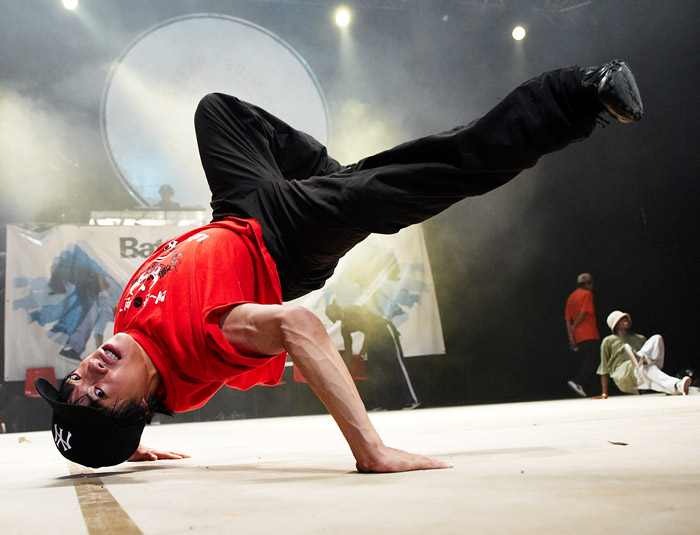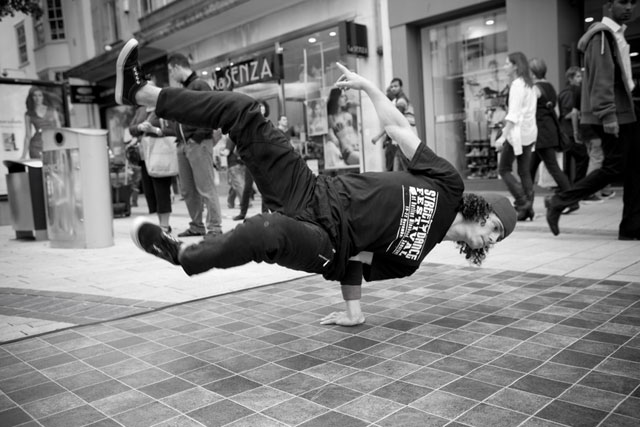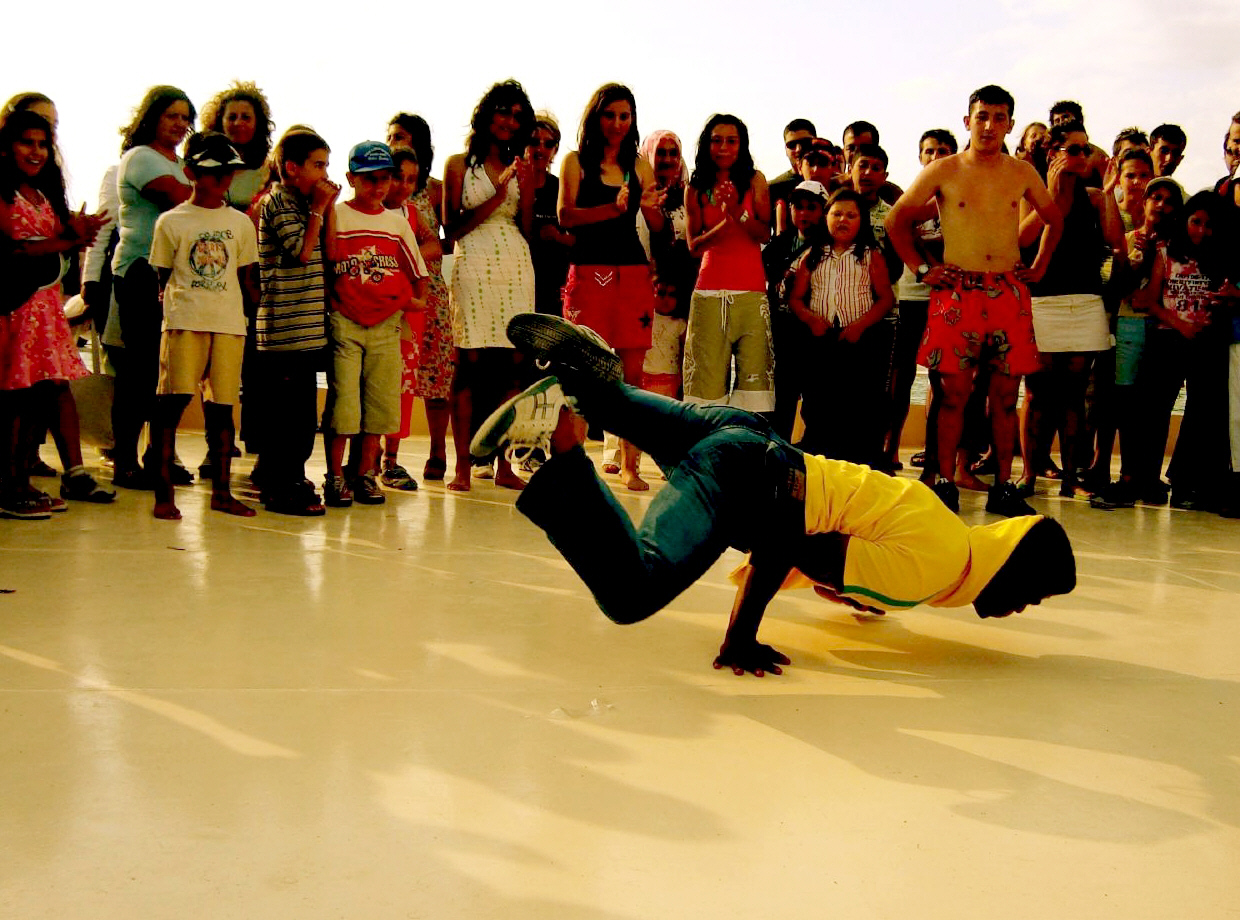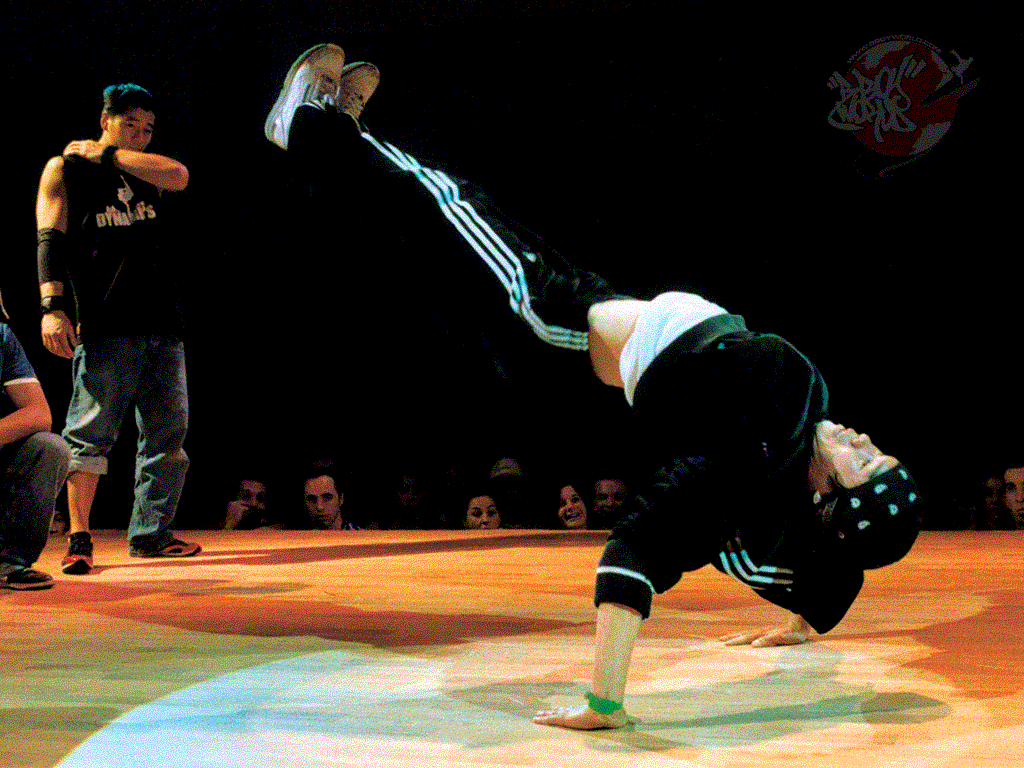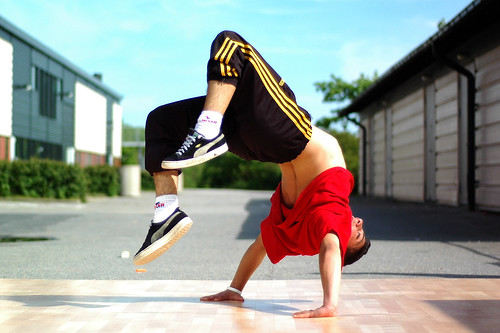B Boying Step|B Boying Step For Beginner|Locking And Poping|Robot Dance|B Boying Cool Wallpapers|B Boying tutorial for beginner|B Boying tutorial|How to learn break dance |How to do break dance:dance,moves,and tips |learn Free online Break dance steps for beginner | B Girl wallpaper |Wild b Boying pic
Monday, March 28, 2011
Bboying
A b-boy (or break-boy) is a male dancer who practices breaking or b-boying, the acrobatic hip-hop dance style commonly known as "break dancing." B-boying, often called "break dancing", is a popular style of street dance that was created and developed as part of hip-hop culture among African Americans and, later, among Latino youths in New York City. The dance consists of four primary elements: top rock, down rock, power moves and freezes/suicides. It is danced to both hip-hop and other genres of music that are often remixed to prolong the musical breaks. The musical selection for b-boying is not restricted to hip-hop music as long as the tempo and beat pattern conditions are met. A practitioner of this dance is called a b-boy, b-girl, or breaker. These dancers often participate in battles, formal or informal dance competitions between two individuals or two crews. Although the term "break dance" is frequently used, "b-boying" and "breaking" are the original terms used to refer to the dance. These terms are preferred by the majority of the art form’s pioneers and most notable practitioners.B boy stands for break boy and is the only true dance of hip hop. The name was givin first by DJ kool Herc to his dancers at one of his famous parties. Break can stand for a few things. It can stand for when the DJ played a song and extended the break for people to dance, and it can also stand for people trying to reach a breaking point in their dancing and trying to reach new limits. The media began to call it "break dancing" but that is not the correct name. Bboying started with top rocking and dancing at parties, then was taken to the floor by people like the nigga twins. Now over time it as progressed and become more acrobatic and has added new style. Bboying is an element of hip hop and is its own dance, but a lot of moves came from a variety of places including tap, jazz, gymnastics, capoeira, and yoga, and keeps on growing.
Popping
Popping was created by Sam Solomon in Fresno, California and performed by his crew the Electric Boogaloos.It is based on the technique of quickly contracting and relaxing muscles to cause a jerk in the dancer's body, referred to as a pop or a hit. Each hit should be synchronized to the rhythm and beats of the music. Popping is also used as an umbrella term to refer to a wide range of other closely related illusionary dance styles such as strobing, liquid, animation, and waving that are often integrated with standard popping to create a more varied performance. In all of these sub-genres it appears to the spectator that the body is popping hence the name. The difference between each sub-genre is how exaggerated the popping is. In liquid the body movements look like water. The popping is so smooth that the movements do not look like popping at all; they look fluid.The opposite of this is strobing (also called ticking) in which the movements are static, sudden, and jerky.
Popping—as an umbrella term—also includes gliding, floating, and sliding which are lower body dances done with the legs and feet. When done correctly a dancer looks like they are gliding across the floor as if on ice.Opposite from gliding is tutting which is an upper body dance that uses the arms, hands, and wrists to form right angles and make geometric box-like shapes. Sometimes the arms are not used at all and tutting is only done with the wrists, hands, and fingers. In both variations, the movements are intricate and always use 90° angles. When done correctly tutting looks like the characters on the art of ancient Egypt hence the name—a reference to King Tut.
While popping as an umbrella term is popularly used by hip-hop dancers and in competitive hip-hop dancing, Popin' Pete of the Electric Boogaloos disagrees with the use of the word "popping" in this way. He states "There are people who wave and there are people who tut. They’re not popping. I say this to give the people who created other styles their just dues and their props."Many of these related styles (animation, liquid, tutting, etc.) can not be traced to a specific person or group. The Electric Boogaloos themselves acknowledge this (see quote box). Other styles may have influences earlier than hip-hop. Earl "Snake Hips" Tucker was a professional dancer in the 1920s who appeared in the film Symphony in Black and performed at the Cotton Club in Harlem.Because hip-hop did not exist in the '20s his style was considered jazz but his "slithering, writhing" movement foreshadowed modern waving and sliding.
Popping—as an umbrella term—also includes gliding, floating, and sliding which are lower body dances done with the legs and feet. When done correctly a dancer looks like they are gliding across the floor as if on ice.Opposite from gliding is tutting which is an upper body dance that uses the arms, hands, and wrists to form right angles and make geometric box-like shapes. Sometimes the arms are not used at all and tutting is only done with the wrists, hands, and fingers. In both variations, the movements are intricate and always use 90° angles. When done correctly tutting looks like the characters on the art of ancient Egypt hence the name—a reference to King Tut.
While popping as an umbrella term is popularly used by hip-hop dancers and in competitive hip-hop dancing, Popin' Pete of the Electric Boogaloos disagrees with the use of the word "popping" in this way. He states "There are people who wave and there are people who tut. They’re not popping. I say this to give the people who created other styles their just dues and their props."Many of these related styles (animation, liquid, tutting, etc.) can not be traced to a specific person or group. The Electric Boogaloos themselves acknowledge this (see quote box). Other styles may have influences earlier than hip-hop. Earl "Snake Hips" Tucker was a professional dancer in the 1920s who appeared in the film Symphony in Black and performed at the Cotton Club in Harlem.Because hip-hop did not exist in the '20s his style was considered jazz but his "slithering, writhing" movement foreshadowed modern waving and sliding.
Locking
 Locking, originally called Campbellocking, was created in Los Angeles by Don Campbell and introduced to the country by his crew The Locker Other than Don Campbell, the original members of The Lockers were Fred "Mr. Penguin" Berry (Rerun on the 1970s TV sitcom What's Happening!!), Leo "Fluky Luke" Williamson, Adolpho "Shabba Doo" Quinones, Bill "Slim the Robot" Williams, Greg "Campbellock Jr" Pope, and Toni Basil who also served as the group's manager.In honor of her instrumental role in giving locking commercial exposure, Basil was honored at the 2009 World Hip Hop Dance Championships as the first female recipient of the Living Legend Award.Locking looks similar to popping and frequently gets confused with popping to a casual observer. In locking, a dancer holds their positions longer. The lock is the primary move used in locking. It is "similar to a freeze or a sudden pause.A locker's dancing is characterized by consistently locking in place and after a quick freeze moving again.It is incorrect to call locking "pop-locking".Locking and popping are two distinct funk styles with their own histories, their own set of dance moves, and their own competition categories. Locking is more playful and character driven whereas popping is more illusory.Locking has specific dance moves that identify it from popping and other funk styles. These moves include "the lock, points, skeeter [rabbits], scooby doos, stop 'n go, which-away, and the fancies.A dancer can do one or the other but not both locking and popping at the same time.It was only after seeing The Lockers perform on TV that a young Sam Solomon was inspired to create popping and electric boogaloo.
Locking, originally called Campbellocking, was created in Los Angeles by Don Campbell and introduced to the country by his crew The Locker Other than Don Campbell, the original members of The Lockers were Fred "Mr. Penguin" Berry (Rerun on the 1970s TV sitcom What's Happening!!), Leo "Fluky Luke" Williamson, Adolpho "Shabba Doo" Quinones, Bill "Slim the Robot" Williams, Greg "Campbellock Jr" Pope, and Toni Basil who also served as the group's manager.In honor of her instrumental role in giving locking commercial exposure, Basil was honored at the 2009 World Hip Hop Dance Championships as the first female recipient of the Living Legend Award.Locking looks similar to popping and frequently gets confused with popping to a casual observer. In locking, a dancer holds their positions longer. The lock is the primary move used in locking. It is "similar to a freeze or a sudden pause.A locker's dancing is characterized by consistently locking in place and after a quick freeze moving again.It is incorrect to call locking "pop-locking".Locking and popping are two distinct funk styles with their own histories, their own set of dance moves, and their own competition categories. Locking is more playful and character driven whereas popping is more illusory.Locking has specific dance moves that identify it from popping and other funk styles. These moves include "the lock, points, skeeter [rabbits], scooby doos, stop 'n go, which-away, and the fancies.A dancer can do one or the other but not both locking and popping at the same time.It was only after seeing The Lockers perform on TV that a young Sam Solomon was inspired to create popping and electric boogaloo.
Dance techniques
There are four primary elements that form breaking. These include toprock, downrock, power moves, and freezes/suicides.
Toprock generally refers to any string of steps performed from a standing position. It is usually the first and foremost opening display of style, though dancers often transition from other aspects of breaking to toprock and back. Toprock has a variety of steps which can each be varied according to the dancer's expression (ie. aggressive, calm, excited). A great deal of freedom is allowed in the definition of toprock: as long as the dancer maintains cleanness, form and the b-boy attitude, theoretically anything can be toprock. Toprock can draw upon many other dance styles such as popping, locking, or house dance. Transitions from toprock to downrock and power moves are called drops.[20]
Downrock (also known as "footwork" or "floorwork") is used to describe any movement on the floor with the hands supporting the dancer as much as the feet. Downrock includes moves such as the foundational 6-step, and its variants such as the 3-step or other small steps that add style. The most basic of downrock is done entirely on feet and hands but more complex variations can involve the knees when threading limbs through each other.
Power moves are acrobatic moves that require momentum, speed, endurance, strength, and control to execute. The breaker is generally supported by his upper body, while the rest of his body creates circular momentum. Notable examples are the windmill, swipe, and head spin. Some power moves are borrowed from gymnastics and martial arts. An example of a power move taken from gymnastics is the Thomas Flair which is shortened and spelled flare in b-boying.
Freezes are stylish poses, and the more difficult require the breaker to suspend himself or herself off the ground using upper body strength in poses such as the pike. They are used to emphasize strong beats in the music and often signal the end of a b-boy set. Freezes can be linked into chains or "freeze ladders" where breakers change positions to the music to display musicality and physical strength.
Suicides like freezes are used to emphasize a strong beat in the music and signal the end to a routine. In contrast to freezes, suicides draw attention to the motion of falling or losing control, while freezes draw attention to a controlled final position. Breakers will make it appear that they have lost control and fall onto their backs, stomachs, etc. The more painful the suicide appears, the more impressive it is, but breakers execute them in a way to minimize pain.
Toprock generally refers to any string of steps performed from a standing position. It is usually the first and foremost opening display of style, though dancers often transition from other aspects of breaking to toprock and back. Toprock has a variety of steps which can each be varied according to the dancer's expression (ie. aggressive, calm, excited). A great deal of freedom is allowed in the definition of toprock: as long as the dancer maintains cleanness, form and the b-boy attitude, theoretically anything can be toprock. Toprock can draw upon many other dance styles such as popping, locking, or house dance. Transitions from toprock to downrock and power moves are called drops.[20]
Downrock (also known as "footwork" or "floorwork") is used to describe any movement on the floor with the hands supporting the dancer as much as the feet. Downrock includes moves such as the foundational 6-step, and its variants such as the 3-step or other small steps that add style. The most basic of downrock is done entirely on feet and hands but more complex variations can involve the knees when threading limbs through each other.
Power moves are acrobatic moves that require momentum, speed, endurance, strength, and control to execute. The breaker is generally supported by his upper body, while the rest of his body creates circular momentum. Notable examples are the windmill, swipe, and head spin. Some power moves are borrowed from gymnastics and martial arts. An example of a power move taken from gymnastics is the Thomas Flair which is shortened and spelled flare in b-boying.
Freezes are stylish poses, and the more difficult require the breaker to suspend himself or herself off the ground using upper body strength in poses such as the pike. They are used to emphasize strong beats in the music and often signal the end of a b-boy set. Freezes can be linked into chains or "freeze ladders" where breakers change positions to the music to display musicality and physical strength.
Suicides like freezes are used to emphasize a strong beat in the music and signal the end to a routine. In contrast to freezes, suicides draw attention to the motion of falling or losing control, while freezes draw attention to a controlled final position. Breakers will make it appear that they have lost control and fall onto their backs, stomachs, etc. The more painful the suicide appears, the more impressive it is, but breakers execute them in a way to minimize pain.
Saturday, March 26, 2011
Wednesday, March 23, 2011
Tuesday, March 22, 2011
Monday, March 21, 2011
Fitness
Today hip-hop dance is recognized by dancers and trainers alike as an alternate form of exercise. Hip Hop International, the organization that runs the USA and the World Hip Hop Dance Championships, was founded as a subsidiary of Sports Fitness International.In 2007 Beachbody, the makers of the P90X workout, produced Hip Hop Abs—a home fitness program created by dancer and personal trainer Shaun that uses hip-hop dance, rather than crunches or sit-ups, to tone and sculpt abs. According to Lance Armstrong's health and fitness website LiveStrong.com, hip-hop dancing is particularly helpful in building abdominal muscle:
“ Many of the hip-hop movements isolate the abs, so this area really gets a good muscle-sculpting workout. There is a great deal of hip rolling, waist and pelvic rolling and popping in hip hop and all of these work the abs. The hip-hop "popping" is a technique that is a quick punch on the emphasis of a beat, many times danced in a combination with arm movements and the abdominal area being "popped" in the same count sequence. Doing these popping movements in repetition is an excellent abdominal workout. ”
In the mid '90s MTV's The Grind premiered. It was a television program that showcased social hip-hop dancing to rap, R&B, and house music. Due to the show's popularity MTV released two The Grind Workout videos hosted by Eric Neis with assistance from choreographer Tina Landon.In the early 2000s Nike launched an international campaign promoting dance as sport and enlisted the help of choreographer and creative director Jamie King to develop the Nike Rockstar Workout for use in gyms worldwide.He later released a companion workout book and DVD titled Rock Your Body.Other choreographers/dancers have used fitness as a platform to promote hip-hop dance as a way to stay in shape. Titles include Darrin's Dance Grooves Vol. 1 – 2, Diversity: Dance Fitness Fusion, and Breakin' It Down with Laurie Ann Gibson.
“ Many of the hip-hop movements isolate the abs, so this area really gets a good muscle-sculpting workout. There is a great deal of hip rolling, waist and pelvic rolling and popping in hip hop and all of these work the abs. The hip-hop "popping" is a technique that is a quick punch on the emphasis of a beat, many times danced in a combination with arm movements and the abdominal area being "popped" in the same count sequence. Doing these popping movements in repetition is an excellent abdominal workout. ”
In the mid '90s MTV's The Grind premiered. It was a television program that showcased social hip-hop dancing to rap, R&B, and house music. Due to the show's popularity MTV released two The Grind Workout videos hosted by Eric Neis with assistance from choreographer Tina Landon.In the early 2000s Nike launched an international campaign promoting dance as sport and enlisted the help of choreographer and creative director Jamie King to develop the Nike Rockstar Workout for use in gyms worldwide.He later released a companion workout book and DVD titled Rock Your Body.Other choreographers/dancers have used fitness as a platform to promote hip-hop dance as a way to stay in shape. Titles include Darrin's Dance Grooves Vol. 1 – 2, Diversity: Dance Fitness Fusion, and Breakin' It Down with Laurie Ann Gibson.
Dance industry
The dance industry responded to hip-hop dance by creating a more commercial version of it. This "studio hip-hop", sometimes called new style is seen in most rap and R&B music videos and concerts. From the point of view of someone deeply immersed in hip-hop culture, anything that looks like hip-hop dance that did not come from the streets is not a true hip-hop dance form. In an interview with Dance magazine, hip-hop dance teacher Emilio "Buddha Stretch" Austin, Jr explains how he sees it:
“ There are a lot of jazz dancers out there doing pseudo hip hop. A lot of teachers don't know the history, they're just teaching the steps. They're learning from videos, but they don't know the culture. If all you see is Britney Spears, you think that's hip hop, but that's never been hip hop. It's completely watered down. And studios could [sic] care less, because hip hop is one of their biggest moneymakers.
Many people echo this sentiment, as stage performance can restrict the free flowing process of improvization which defined hip-hop dance early in its development.Also meshing different dance styles together dissolves their structures and identities.
From a technical aspect, hip-hop dance (new style) is characterized as hard-hitting involving flexibility and isolations—moving a certain body part independently from others.The feet are grounded, the chest is down, and the body is kept loose so that a dancer can easily alternate between hitting the beat or riding through the beat. This is in contrast to ballet or ballroom dancing where the chest is upright and the body is stiff. In addition, new style hip-hop is very rhythmic and emphasis is placed on musicality—how sensitive your movements are to the music—and being able to freestyle (improvise). As long as dancers maintain the foundational movements, they can add their own (free)style and have a performance that is still hip-hop.
Another style the dance industry created was jazz funk. Jazz funk (also called street jazz) is a hybrid of hip-hop and jazz dance.This style is used by artists like Beyoncé.Although it borrows from hip-hop dance, it is not considered a style of hip-hop because the foundational movements are jazz. In hip-hop – even in lyrical hip-hop – there are no pirouettes or arabesques and you do not dance on relevé (on the balls of the feet). However, these methods are used in jazz funk and in jazz dance in general.Dance studios responded to these new styles by hiring technically trained dancers and offering hip-hop (new style) and jazz funk dance classes. Large scale studios around the world that teach hip-hop and jazz funk dance classes include Millennium (L.A.), Broadway Dance Center (New York), Edge Performing Arts Center (L.A.), Pineapple Studios (London), The Vibe – The International Hip Hop Dance Center (Oslo), Boogiezone (L.A.), Debbie Reynolds (L.A.), Sunshine Studios (Manchester), DREAM Dance Studio (Vancouver), Ones to Watch (Japan & Hong Kong), and KJD Dance Studio (Sydney).
Other developments in the industry came about in response to the growing popularity of hip-hop dance. On the traveling convention circuit there were tap, ballet, and jazz dance conventions but there were none specifically for hip-hop. The same void also translated to dancewear. There was dancewear for tap, ballet, and jazz dancers but none for hip-hop dancers. Monsters of Hip Hop and Nappytabs dancewear were formed to cater to both needs. Monsters of Hip Hop is the first all hip-hop dance convention. It was founded in 2003 in Baltimore by Andy Funk, his wife Becky, and her sister Angie Servant.The convention now travels to multiple US cities and to Mexico.Its faculty roster includes Dave Scott, Teresa Espinosa, Popin Pete, and Marty Kudelka among others.Nappytabs is the first line of dancewear made specifically for hip-hop dancers.Their line is only sold at dance clothing stores, online through their official website, and at their only retail location and studio in Los Angeles. Because Nappytabs is made for the urban dance community they do not sell leotards/unitards, tights, or leg warmers. Their line consist of tanks, shorts, t-shirts, sweats, and hoodies.
Threader is an online distribution outlet for hip-hop dance inspired streetwear created by hip-hop choreographers and dance crews.It was founded in 2009 by Traci Copeland, Marc David, and choreographer Luam Keflezgy. Threader has distributed clothing for brands/dancers such as Shoeture, Poreotics, Wildchild, Beat Freaks, Dance2XS, and Laurie Ann Gibson
“ There are a lot of jazz dancers out there doing pseudo hip hop. A lot of teachers don't know the history, they're just teaching the steps. They're learning from videos, but they don't know the culture. If all you see is Britney Spears, you think that's hip hop, but that's never been hip hop. It's completely watered down. And studios could [sic] care less, because hip hop is one of their biggest moneymakers.
Many people echo this sentiment, as stage performance can restrict the free flowing process of improvization which defined hip-hop dance early in its development.Also meshing different dance styles together dissolves their structures and identities.
From a technical aspect, hip-hop dance (new style) is characterized as hard-hitting involving flexibility and isolations—moving a certain body part independently from others.The feet are grounded, the chest is down, and the body is kept loose so that a dancer can easily alternate between hitting the beat or riding through the beat. This is in contrast to ballet or ballroom dancing where the chest is upright and the body is stiff. In addition, new style hip-hop is very rhythmic and emphasis is placed on musicality—how sensitive your movements are to the music—and being able to freestyle (improvise). As long as dancers maintain the foundational movements, they can add their own (free)style and have a performance that is still hip-hop.
Another style the dance industry created was jazz funk. Jazz funk (also called street jazz) is a hybrid of hip-hop and jazz dance.This style is used by artists like Beyoncé.Although it borrows from hip-hop dance, it is not considered a style of hip-hop because the foundational movements are jazz. In hip-hop – even in lyrical hip-hop – there are no pirouettes or arabesques and you do not dance on relevé (on the balls of the feet). However, these methods are used in jazz funk and in jazz dance in general.Dance studios responded to these new styles by hiring technically trained dancers and offering hip-hop (new style) and jazz funk dance classes. Large scale studios around the world that teach hip-hop and jazz funk dance classes include Millennium (L.A.), Broadway Dance Center (New York), Edge Performing Arts Center (L.A.), Pineapple Studios (London), The Vibe – The International Hip Hop Dance Center (Oslo), Boogiezone (L.A.), Debbie Reynolds (L.A.), Sunshine Studios (Manchester), DREAM Dance Studio (Vancouver), Ones to Watch (Japan & Hong Kong), and KJD Dance Studio (Sydney).
Other developments in the industry came about in response to the growing popularity of hip-hop dance. On the traveling convention circuit there were tap, ballet, and jazz dance conventions but there were none specifically for hip-hop. The same void also translated to dancewear. There was dancewear for tap, ballet, and jazz dancers but none for hip-hop dancers. Monsters of Hip Hop and Nappytabs dancewear were formed to cater to both needs. Monsters of Hip Hop is the first all hip-hop dance convention. It was founded in 2003 in Baltimore by Andy Funk, his wife Becky, and her sister Angie Servant.The convention now travels to multiple US cities and to Mexico.Its faculty roster includes Dave Scott, Teresa Espinosa, Popin Pete, and Marty Kudelka among others.Nappytabs is the first line of dancewear made specifically for hip-hop dancers.Their line is only sold at dance clothing stores, online through their official website, and at their only retail location and studio in Los Angeles. Because Nappytabs is made for the urban dance community they do not sell leotards/unitards, tights, or leg warmers. Their line consist of tanks, shorts, t-shirts, sweats, and hoodies.
Threader is an online distribution outlet for hip-hop dance inspired streetwear created by hip-hop choreographers and dance crews.It was founded in 2009 by Traci Copeland, Marc David, and choreographer Luam Keflezgy. Threader has distributed clothing for brands/dancers such as Shoeture, Poreotics, Wildchild, Beat Freaks, Dance2XS, and Laurie Ann Gibson
Dance Crew
A dance crew is a group of street dancers who get together and create dance routines. As hip-hop culture spread throughout New York, the more breaking crews got together to practice and battle against each other. It was during this time that the different dance moves within breaking would develop organically.The same can be said about different dance moves within the funk styles – popping and locking – and decades later with krumping. Being a part of a crew was the only way to learn when these styles began. Forming and participating in a dance crew is how you practiced, improved, made friends, and built relationships. In the beginning, crews were neighborhood-based and would engage in battles in their respective cities. Today, crews can battle in organized competitions with other crews from around the country and around the world.
Crews still form based on friendships and neighborhoods (ex: Diversity). They also form for a variety of other reasons such as theme (JabbaWockeeZ), gender (Beat Freaks), ethnicity (Kaba Modern), and dance style (We Are Heroes). Crews are not exclusive. It is common for dancers to be involved in more than one crew, especially if one particular group is style specific (popping only for example) and a dancer wants to stay well-rounded.Furthermore, dance crews are not just formed within the hip-hop context anymore. The FootworKINGz is a dance crew that performs footwork, a style of house dance, and Fanny Pak does contemporary.
Although dance crews are more prevalent in hip-hop, dance companies do exist in both the United States and abroad. Examples include Culture Shock (USA), Lux Aeterna (USA),[note 9] Boy Blue Entertainment (UK), Bounce Streetdance Company (Sweden), 2Faced Dance (UK), Funkbrella Dance Company (USA), Blaze Streetdance Company (Netherlands), and Zoo Nation (UK).
Crews still form based on friendships and neighborhoods (ex: Diversity). They also form for a variety of other reasons such as theme (JabbaWockeeZ), gender (Beat Freaks), ethnicity (Kaba Modern), and dance style (We Are Heroes). Crews are not exclusive. It is common for dancers to be involved in more than one crew, especially if one particular group is style specific (popping only for example) and a dancer wants to stay well-rounded.Furthermore, dance crews are not just formed within the hip-hop context anymore. The FootworKINGz is a dance crew that performs footwork, a style of house dance, and Fanny Pak does contemporary.
Although dance crews are more prevalent in hip-hop, dance companies do exist in both the United States and abroad. Examples include Culture Shock (USA), Lux Aeterna (USA),[note 9] Boy Blue Entertainment (UK), Bounce Streetdance Company (Sweden), 2Faced Dance (UK), Funkbrella Dance Company (USA), Blaze Streetdance Company (Netherlands), and Zoo Nation (UK).
History of hiphop dance
Hip-hop dance as seen today is a broad category that incorporates a variety of old and new urban dance styles. The older styles that were created in the 1970s include up rock, breaking, and the funk styles.These dance styles all started independent of each other, half of them in New York and the others in California. Up rock was created in Brooklyn, N.Y. and breaking was created in The Bronx. In its earliest form, breaking began as elaborations on James Brown's Good Foot" dance which came out in 1972. Breaking at this stage was not primarily floor oriented as is seen today; it started out as top rock which is performed standing up. In 1973, DJ Kook Herc invented the breakbeat.A breakbeat is a rhythmic musical interlude of a song that has been looped over and over again to extend that instrumental solo. Kool Herc did this to provide a means for dancers who attended his parties to show their skills.B-boy and b-girl stands for "break-boy" and "break-girl"; b-boys/b-girls dance to the break of a record.Another influence on top rock was up rock.Up rock looks similar to top rock but it is more aggressive and is meant look like a fight. Unlike top rock, up rock was not performed to break beats. The song was played from start to finish.Also, up rocking is done with partners but in breaking each person takes turns dancing.Further influenced by gymnastics and martial arts, breaking went from being a purely upright dance style—toprock only—to becoming more floor oriented. The funk styles refers to several street dance styles created in California in the 1970s that were danced to funk music.These styles include roboting, bopping, hitting, locking, bustin', popping, electric boogaloo, strutting, sac-ing, dime-stopping, etc.Similar to breaking, James Brown also had a big impact on the boogaloo style of dance. One of Sam Solomon's inspirations for creating boogaloo was James Brown's dance "the popcorn" and the name of the dance was taken from the title of the James Brown song "Do the Boogaloo".The most popular and widely practiced of the funk styles are locking and popping. Locking is the older of the two and was created by Don Campbell in the late 1960s. Popping was created by Sam Solomon in the 1970s. The 1980s media incorrectly brought these styles under the "breakdance"/"breakdancing" label causing a confusion about their origin.They were created on the west coast separate from breaking and came out of the funk cultural movement rather than from the hip-hop cultural movement. The television show, Soul Train, helped to spread locking and popping's popularity. Both The Lockers and the Electric Boogaloos—dance crews responsible for the spread of locking and popping—performed on this show.Today, the funk styles are now performed to both hip-hop and funk music.
Hip-hop dance
Hip-hop dance refers to dance styles primarily danced to hip-hop music or that have evolved as part of hip-hop culture. This includes a wide range of styles notably breaking, locking, and popping which were developed in the 1970s by Black and Latino Americans. What separates hip-hop dance from other forms of dance is that it is often freestyle (improvisational) in nature and hip-hop dancers frequently engage in battles—formal or informal freestyle dance competitions. Informal freestyle sessions and battles are usually performed in a cipher, "a circular dance space that forms naturally once the dancing begins.These three elements—free styling, battles, and ciphers—are key components of hip-hop dance.
More than 30 years old, hip-hop dance became widely known after the first professional breaking, locking, and popping crews formed in the 1970s. The most influential groups are the Rock Steady Crew, The Lockers, and the Electric Boogaloos who are responsible for the spread of breaking, locking, and popping respectively. Parallel with the evolution of hip-hop music, hip-hop dancing evolved from breaking and the funk styles into different forms: moves such as the "running man" and the "cabbage patch" hit the mainstream and became fad dances. The dance industry in particular responded with a studio based version of hip-hop—sometimes called new style— and jazz funk. These styles were developed by technically trained dancers who wanted to create choreography for hip-hop music from the hip-hop dances they saw being performed on the street. Because of this development, hip-hop dance is now practiced at both studios and outside spaces.
Internationally, hip-hop dance has had a particularly strong influence in France and South Korea. France is the birthplace of Tecktonik, a style of house dance from Paris that borrows heavily from popping and breaking. France is also the home of Juste Debout, an international hip-hop dance competition. South Korea is home to the international breaking competition R16 which is sponsored by the government and broadcast every year live on Korean television. The country consistently produces such skillful b-boys that the South Korean government has designated the Gamblerz and Rivers b-boy crews official ambassadors of Korean culture.
To some, hip-hop dance may only be a form of entertainment or a hobby. To others it has become a lifestyle: a way to be active in physical fitness or competitive dance and a way to make a living by dancing professionally.
More than 30 years old, hip-hop dance became widely known after the first professional breaking, locking, and popping crews formed in the 1970s. The most influential groups are the Rock Steady Crew, The Lockers, and the Electric Boogaloos who are responsible for the spread of breaking, locking, and popping respectively. Parallel with the evolution of hip-hop music, hip-hop dancing evolved from breaking and the funk styles into different forms: moves such as the "running man" and the "cabbage patch" hit the mainstream and became fad dances. The dance industry in particular responded with a studio based version of hip-hop—sometimes called new style— and jazz funk. These styles were developed by technically trained dancers who wanted to create choreography for hip-hop music from the hip-hop dances they saw being performed on the street. Because of this development, hip-hop dance is now practiced at both studios and outside spaces.
Internationally, hip-hop dance has had a particularly strong influence in France and South Korea. France is the birthplace of Tecktonik, a style of house dance from Paris that borrows heavily from popping and breaking. France is also the home of Juste Debout, an international hip-hop dance competition. South Korea is home to the international breaking competition R16 which is sponsored by the government and broadcast every year live on Korean television. The country consistently produces such skillful b-boys that the South Korean government has designated the Gamblerz and Rivers b-boy crews official ambassadors of Korean culture.
To some, hip-hop dance may only be a form of entertainment or a hobby. To others it has become a lifestyle: a way to be active in physical fitness or competitive dance and a way to make a living by dancing professionally.
Subscribe to:
Posts (Atom)




